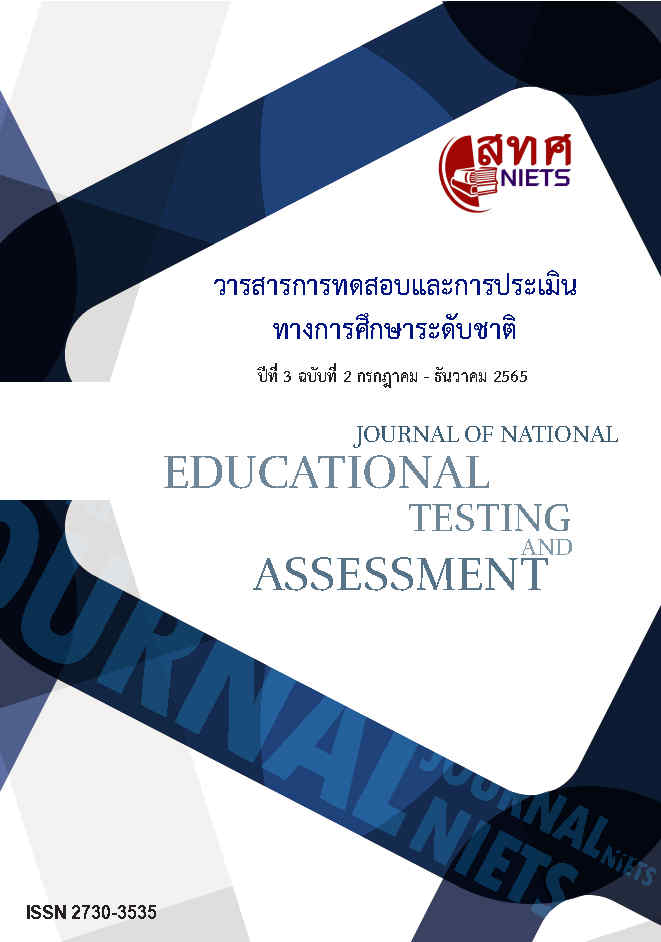องค์ประกอบและตัวชี้วัดในการประเมินคุณภาพพื้นที่สาธารณะเมืองตามการรู้ ของบุคคลที่มีความต้องการพิเศษ
Main Article Content
บทคัดย่อ
พื้นที่สาธารณะที่ส่งเสริมการเรียนรู้และคุณภาพชีวิตสำหรับบุคคลที่มีความต้องการพิเศษ
ในกรุงเทพมหานครยังมีความจำกัด โดยพื้นที่มิใช่เพียงสิ่งแวดล้อมทางกายภาพ แต่เป็นพื้นที่ทางสังคมและปฏิสัมพันธ์ระหว่างบุคคล งานวิจัยนี้ต้องการนำเสนอตัวชี้วัดคุณภาพของพื้นที่สาธารณะของเมืองตามการรับรู้ของบุคคลที่มีความต้องการพิเศษ โดยพัฒนาองค์ประกอบและตัวชี้วัดการเข้าถึง เข้าใช้ และใช้งาน พื้นที่สาธารณะในกรุงเทพมหานครจากการทบทวนวรรณกรรมที่เกี่ยวข้อง สร้างเป็นแบบประเมิน และตรวจสอบคุณภาพเครื่องมือโดยผู้เชี่ยวชาญ จำนวน 4 คน นำไปทดลองใช้กับบุคคลที่มีความต้องการพิเศษหรือผู้ดูแลหลักของบุคคลที่มีความต้องการพิเศษ จำนวน 20 คน วิเคราะห์ข้อมูลโดยการแจกแจงความถี่
หาค่าเฉลี่ย ส่วนเบี่ยงเบนมาตรฐาน หาค่า IOC ค่าความเชื่อมั่น และการวิเคราะห์เนื้อหา ผลการศึกษา พบว่า การประเมินคุณภาพของพื้นที่สาธารณะในกรุงเทพมหานครตามการรับรู้ของบุคคลที่มีความต้องการพิเศษ ประกอบด้วย 4 องค์ประกอบ 10 ตัวชี้วัด ได้แก่ องค์ประกอบที่ 1 กิจกรรมและการใช้งาน มี 3 ตัวชี้วัด องค์ประกอบที่ 2 การเข้าถึงและการเชื่อมต่อ มี 2 ตัวชี้วัด องค์ประกอบที่ 3 การมีปฏิสัมพันธ์ทางสังคม
มี 2 ตัวชี้วัด และองค์ประกอบที่ 4 การรับรู้ มี 3 ตัวชี้วัด
Article Details

อนุญาตภายใต้เงื่อนไข Creative Commons Attribution-NonCommercial-NoDerivatives 4.0 International License.
under process
เอกสารอ้างอิง
ภาษาไทย
ณัฐกุล ตันติไพจิตร. (2556). สนามเด็กเล่นสำหรับเด็กพิเศษ [สารนิพนธ์ปริญญามหาบัณฑิต ไม่ได้ตีพิมพ์]. มหาวิทยาลัยศิลปากร. http://www.thapra.lib.su.ac.th/objects/thesis/fulltext/
thapra/Nattakun_Tantiphaichit/fulltext.pdf
ณิชาพร ศรีเพชรดี. (2561ก). EP.1: The twelve senses ปรัชญาการเติบโตของมนุษย์ตั้งแต่ระดับ ‘เซลล์’
และ ‘โซล’. Thepotential. https://thepotential.org/knowledge/the-twelve-senses-1/
ณิชาพร ศรีเพชรดี. (2561ข). EP.2: The twelve senses ปรัชญาการเติบโตของมนุษย์ตั้งแต่ระดับ ‘เซลล์’
และ ‘โซล’. Thepotential. https://thepotential.org/knowledge/the-twelve-senses-2/
ณิชาพร ศรีเพชรดี. (2561ค). EP.3: The twelve senses ปรัชญาการเติบโตของมนุษย์ตั้งแต่ระดับ ‘เซลล์’
และ ‘โซล’. Thepotential. https://thepotential.org/knowledge/the-twelve-senses-3/
ณิชากร ศรีเพชรดี. (2562). The 12 senses กับหมอปอง: ทำไมเด็กรุ่นใหม่ไม่รู้จักกาลเทศะ ไม่เห็นอก
เห็นใจ และไม่มี common sense. Thepotential. https://thepotential.org/knowledge
/doctor-pong-12-senses/
ภาคีเครือข่ายการศึกษาเพื่อการเยียวยา. (2564). โลกวิเศษเพราะคนพิเศษ: คู่มือสังคมไทยเข้าใจคนพิเศษ เล่ม 1. กู๊ดเฮด พริ้นท์ติ้ง แอนด์แพคเกจจิ้ง กรุ๊ป. http://www.curativethailand.com/pdfbook/Loose%20Part%20Filp/201/01_2021-10-29_06-39-33.html
วารี ถิระจิตร. (2541). การศึกษาสําหรับเด็กพิเศษ. สำนักพิมพ์จุฬาลงกรณ์มหาวิทยาลัย.
สรินยา ศรีเพชราวุธ. (2562). การทํากิจกรรมบําบัด Sensory Integration.
https://home.kku.ac.th/autistic/th/images/stories/docandpdf/si.pdf
ภาษาอังกฤษ
Case, B. J. (2003). Universal Design. Pearson.
Children with Special Needs. (2019). M&L special needs planning.
https://specialneedsplanning.net/children-with-special-needs/
Commission for Architecture and the Built Environment, United Kingdom [CABE]. (2006). The principles of inclusive design (They include you). Commission for Architecture and the Built Environment.
Gehl, J., & Gemzoe, L. (1996). Public Spaces Public Life. Forlag.
Pineda, V. S., & Corburn, J. (2020). Disability, Urban health equity, and the Coronavirus pandemic: Promoting cities for all. Journal Urban Health, 98(2), 308. https://doi.org/10.1007/s11524-020-00437-7
Project for Public Spaces [PPS]. (2000). How to turn a place around: A handbook for creating successful public spaces. PPS.
Public space & the right to the city. (2019). uclg-planning. https://www.uclg-planning.org/public-space-right-city
Pupphachai. U. (2019). Quality of urban space. https://medium.com/umapupphachai/quality-of-urban-space-2f749900f320
Rad, V. R., & Ngah, I. B. (2014). Assessment of quality of public urban spaces. Sci.Int(Lahore), 26(1), 335-338. http://www.sci-int.com/pdf/200550752865-335-338--Bigdeli%20Rad--SS--MALAYSIA--PAID[2]%20GP%20Revised%20Back.pdf
Salama, A. M., Remali, A. M., & MacLean, L. (2017). Characterisation and System Assessment of Urban Open Spaces in Glasgow City Center. Spatium, 37(June 2017), 22 -33. https://doi.org/10.2298/SPAT1737022S
Sepe, M. (2021). Covid-19 pandemic and public spaces: Improving quality and flexibility for healthier place. Urban Design International, 26, 159 – 173. https://link.springer.com/article/10.1057/s41289-021-00153-x
Waldorf publication. (2016a1). Twelve senses: Not just five in the human being - part I.
https://www.waldorfpublications.org/blogs/book-news/twelve-senses-not-just-five-in-
the-human-being
Waldorf publication. (2016a2). Twelve senses: Not just five in the human being - part III.
https://www.waldorfpublications.org/blogs/book-news/twelve-senses-not-just-five-in-
the-human-being-part-3?_pos=1&_sid=8eba16b8b&_ss=rr
Whyte, W. H. (1980). The social life of small urban spaces. The Conservation Foundation.
Wojnarowska, A. (2016). Model for assessment of public space quality in town centers. European Spatial Research and Policy, 23(1), 82-109. http://cejsh.icm.edu.pl/cejsh/element/bwmeta1.element.hdl_11089_18845
Zandieh, R., Nieuwenhuijsen, M., & Zandieh, M. (2020). Adaptability of public spaces and mental health inequalities during the Covid-19 pandemic. Journal of Urban Design and Mental Health, 6, 5. https://www.urbandesignmentalhealth.com/journal-6-covid19-public-spaces.html


